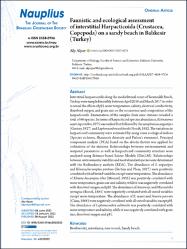Faunistic and ecological assessment of interstitial Harpacticoida (Crustacea, Copepoda) on a sandy beach in Balikesir (Turkey)

Göster/
Erişim
info:eu-repo/semantics/openAccessAttribution 3.0 United Stateshttp://creativecommons.org/licenses/by/3.0/us/Tarih
2022Üst veri
Tüm öğe kaydını gösterÖzet
Interstitial harpacticoids along the mediolittoral zones of Sarımsaklı Beach,
Turkey, were sampled monthly between April 2016 and March 2017 in order
to reveal the effects of pH, water temperature, salinity, electrical conductivity,
dissolved oxygen, and grain size on the occurrence and composition of the
harpacticoids. Examination of the samples from nine stations revealed a
total of 66 species. In terms of harpacticoid species abundance, Ectinosoma
soyeri Apostolov, 1975 was ranked first followed by Sarsamphiascus angustipes
(Gurney, 1927) and Leptomesochra eulitoralis Noodt, 1952. The variations in
harpacticoid community were estimated by using some ecological indices
(Species richness, Shannon’s diversity and Pielou’s evenness). Principal
component analysis (PCA) based on the abiotic factors was applied for
ordination of the stations. Relationships between environmental and
temporal parameters as well as harpacticoid community structure were
analyzed using distance-based Linear Models (DistLM). Relationships
between environmental variables and most abundant species were determined
with the Redundancy analysis (RDA). The abundance of S. angustipes
and Klieonychocamptus ponticus (Serban and Plesa, 1957) were positively
correlated with all tested variables except water temperature. The abundance
of Klieonychocamptus kliei (Monard, 1935) was positively correlated with
water temperature, grain size and salinity, while it was negatively correlated
with dissolved oxygen and pH. The abundance of Ameira sp. and Microsetella
norvegica (Boeck, 1865) were negatively correlated with all tested variables
except water temperature. The abundance of E. soyeri and Ameira parvula
(Claus, 1866) were negatively correlated with all tested variables except pH.
The abundance of Leptomesochra eulitoralis was positively correlated with
water temperature and salinity, while it was negatively correlated with grain
size, dissolved oxygen and pH.


















